There are ten species of turtles in Michigan, 9 native species, and one introduced. Turtles can be found in nearly every state, and even up into Canada. It’s no surprise that these hardy reptiles can be found in the state of Michigan.
Michigan is nearly completely surrounded by Great Lakes, and in some instances, turtles inhabit these lakes. Most prefer to stay in smaller bodies of water, but wherever you go in the Great Lake State, you may see different species of turtles if you look closely.
Here’s our guide to the ten turtle species found in Michigan.
Table of Contents
Turtles in Michigan
1. Blanding’s Turtle

- Experience Level: Intermediate
- Family: Emydidae
- Scientific Name: Emydoidea blandingii
- Other Names: N/A
- Adult Size: 5 to 8 inches (12.5 to 20 cm)
- Life Span: Up to 80 years
- Average Price Range: $300 to $450
- Conservation Status: Endangered
Named after naturalist William Blanding, these turtles have highly domed, dark, oval shells covered in yellow speckles. These spots on older adults may be faded or difficult to see, but you’ll definitely know it’s a Blanding’s turtle because of the bright yellow underside of the neck and chin.
Because of the way the mouth on these turtles is curved, it appears to have a permanent smile. This is why some refer to this turtle as the one that smiles.
Their plastron (bottom half of the shell) is yellowish and has black patches along the edges. This part of the shell is also hinged and can close up for protection from predators.
Raccoons are big turtle predators. There is a population explosion of these ringtailed-bandits, and since the competition for food is fierce, some have turned to eating turtles and their eggs.
Blanding’s turtles like to live in shallow waters with little current and a lot of vegetation. These places include bogs, marshes, ponds, and small inlets and coves.
These turtles can live for nearly a century! In fact, scientists have found that these turtles don’t show signs of aging, even into their 70s and 80s. They can still mate and lay eggs at these ages and beyond!
Blanding’s turtles are omnivores that feed on the vegetation they like to hide among, crayfish, tadpoles, leeches, fish, and insects.
Map Turtles in Michigan
2. Northern Map Turtle

- Experience Level: Beginner
- Family: Emydidae
- Scientific Name: Graptemys geographica
- Other Name: Common map turtle
- Adult Size: Between 4 and 10 ½ inches
- Life Span: 15 to 20 years
- Average price range: Between $20 and $60
- Conservation Status: Least concern
Northern Map turtles are a beautiful species if you happen to see them before they slip into the water and hide. They have a ridged, green or grey carapace (upper shell) with orange, yellow, or tan swirls and scribbles that look like map lines.
The back of the carapace is serrated and the skin has a ton of stripes. The stripes can be yellow or orange on a green background. On the Northern Map turtle, you may be able to see a triangular spot just behind the eyes.
All of these markings tend to get dull and muted as the turtle ages.
Map turtles like large bodies of water such as lakes, and can sometimes be seen along the edges of the Great lakes. These turtles like to bask in the sun, and will occasionally leave the water to find proper nesting sites, but they rarely leave the water for any other reasons.
Map turtles are mostly carnivorous, feeding on snails, clams, and crayfish, but they will occasionally munch on various types of vegetation.
Musk Turtles in Michigan
3. Eastern Musk Turtle
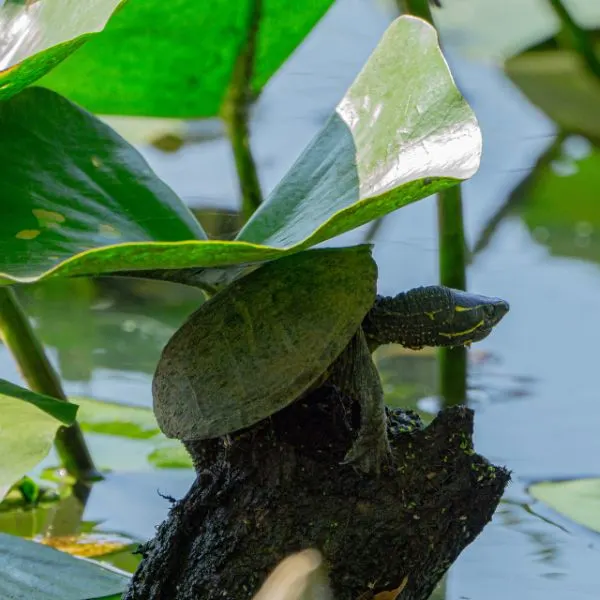
- Experience Level: Intermediate
- Family: Kinosternidae
- Scientific Name: Sternotherus odoratus
- Other Names: Common Musk turtle, Stinkpot
- Adult Size: 4 to 5 inches (10 to 12.5 cm)
- Life Span: 30 to 50 years
- Average Price Range: $30 to $120
- Conservation Status: Least concern
Eastern Musk turtles are small turtles with big attitudes. When they are threatened they can release a foul miasma of stench from musk glands near their backsides. This release of stink gives them the nickname “Stinkpots.” Along with the musk, this turtle can and will attempt to bite, so it’s best to just let them be.
To identify the Eastern Musk turtle, look for an oval shaped, high-domed, dark shell that’s often covered in mud and algae because they rarely leave the water. They also have a pointed head with a pair of stripes on each side.
Musk turtles prefer to live in permanent bodies of water. They don’t want to have to pack up and move often because they are so small. You’ll find these turtles in ponds, lakes, marshes, swamps, and rivers.
These turtles aren’t great swimmers. They use vegetation and the bottom of the water to search for slow moving food. Musk turtles eat crayfish, mollusks, tadpoles, leeches, dead fish, and some vegetation.
Snapping Turtles in Michigan
4. Common Snapping Turtle
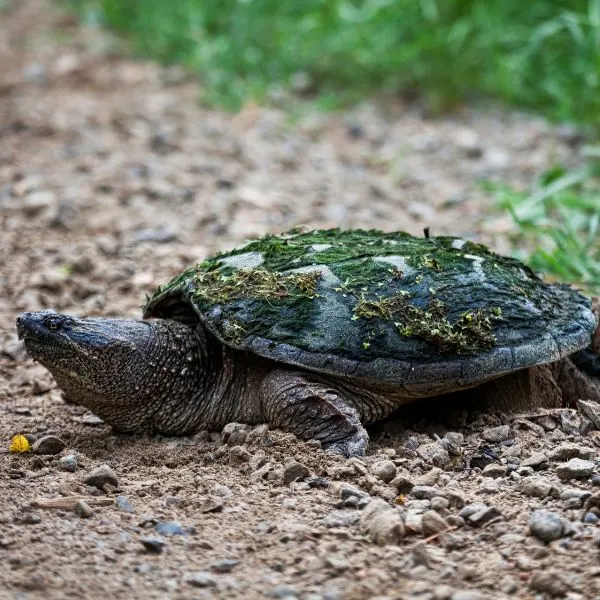
- Experience level: Intermediate to Expert
- Family: Chelydrida
- Scientific Name: Chelydra Serpentina
- Other Names: Snapping Turtle, Snapper, Eastern Snapping Turtle
- Average Adult Size: 8 to 20 inches
- Life Span: 30 – 50 years
- Average Price Range: Approximately $40 to $120
- Conservation Status: Least concern
It’s hard to misidentify the Common Snapping turtle. They are very large turtles that don’t really fit in their shell. Their carapace is thick, has three ridges near the back, dark colored, and is often covered in mud and algae.
They have long tails with upright scales reminiscent of prehistoric creatures. They have long, muscular legs and a broad head on a long neck. If you approach them on land they will back up, open their wide mouths, and hiss.
If that hint isn’t enough to keep you away, the Snapper will do just that. They will strike out lightning fast and bite. If they grab hold of flesh, they can cut through and do some damage.
Snapping turtles don’t have much protection from their shells out of the water, so they feel vulnerable. As long as you give this turtle plenty of space, they have no reason to try and hurt you. They just want to be left alone to do their thing.
Their skin can be yellow, brown, or close to black, and if you happen to see the plastron, you’ll see that it’s very tiny and white.
Snappers prefer water that has a soft, muddy bottom so they can bury themselves and wait for food to come to them. They rarely bask, but when they do, they tend to swim to the surface of the water instead of coming out.
These turtles are mostly carnivorous and will eat nearly anything that they can fit in their large mouths. This includes fish, amphibians, small turtles, and rarely small waterfowl.
Box Turtles in Michigan
5. Eastern Box Turtle

- Experience Level: Beginner
- Family: Emydidae
- Scientific Name: Terrapene carolina carolina
- Other Names: Land Turtle
- Adult Size: 4 to 7 inches
- Life Span: 50 to 100 years
- Average Price Range: $260 – $360
- Conservation Status: Michigan, New Hampshire, Massachusetts, and Connecticut—list the animal as a species of special concern, and Maine lists the turtle as endangered.
Eastern Box turtles are Michigan’s only terrestrial turtle. They spend most of their time wandering along damp forest floors, fields, and other similar areas near water. They aren’t great swimmers and don’t enter the water often.
When they aren’t buried underneath leaf litter and underbrush, you can identify these turtles by their highly domed, dark shells. Each ridged scute has yellow, orange, or red markings. Their skin and scales are nearly the same colors as the carapace.
Their plastron has two hinges, one at the front, and one at the back that allows them to withdraw completely into the shell when threatened.
There isn’t much that the Eastern Box turtle won’t eat. They will eat fungi, insects, plants, worms, snails and slugs, and sometimes carrion. When blackberries and raspberry plants are plentiful, these turtles will gorge themselves on the fruit.
Box turtles are seed dispersers. After they eat fruits with small seeds, they will poop the seeds in different locations to help spread native plants around.
Painted Turtles in Michigan
There are 4 separate subspecies of Painted turtles and 2 that can be found in Michigan. The Midland and Western Painted turtles.
At first glance, these subspecies are difficult to determine apart. Painted turtles have smooth, slightly domed shells that are generally olive, or nearly black. They have red or orange markings along the bottom part of their marginal scutes and have dark skin with yellow, red, or cream colored stripes.
Painted turtles are the most widespread turtle species in the United States. They can inhabit nearly any type of freshwater, but prefer slow-moving waters with soft bottoms and abundant vegetation.
6-A. Midland Painted Turtle

- Experience Level: Beginner
- Family: Emydidae
- Scientific Name: Chrysemys picta marginata
- Other Names: N/A
- Adult Size: Between 4 and 10 inches
- Life Span: Between 30 and 50 years
- Average price range: Between $30 and $150
- Conservation Status: Special concern
To identify a Midland Painted turtle, you have to look closely at its plastron. This may be a difficult feat in the wild because they will often retreat to the water when they notice any disturbance.
This turtle has a tan or cream colored plastron, and a darker patch along the midline.
Midland Painted turtles eat a varied diet of plants, insects, and small aquatic fish and invertebrates.
6-B. Western Painted Turtle

- Experience Level: Beginner
- Family: Emydidae
- Scientific Name: Chrysemys Picta Belli
- Other Names: N/A
- Adult Size: Between 4 and 10 inches
- Life Span: Between 30 and 50 years
- Average Price Range: Between $30 and $150
- Conservation Status: Least concern
Western Painted turtles have bright red plastrons with black and tan “butterfly” patterns that look like the plastron was painted on one side and then folded in half. Did you do similar projects like that in grade school art classes?
Painted turtles are often found basking in the sun. Many turtles will crowd fallen logs, rocky ridges, or the banks of the water.
Western Painted turtles are omnivores that will eat algae, plants, crustaceans, mollusks, insects, fish, tadpoles, and anything else small enough to bite and swallow.
Pond Sliders in Michigan
7. Red Eared Slider
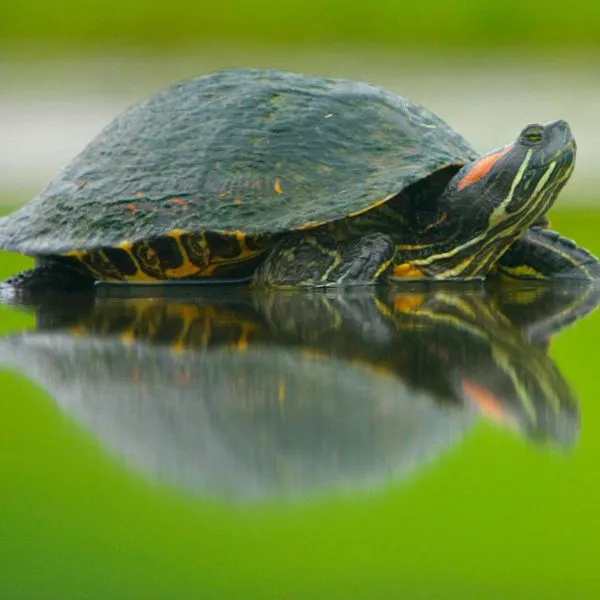
- Experience level: Beginner
- Family: Emydidae
- Scientific Name: Trachemys scripta elegans
- Common Name: Pond slider, Red-eared terrapin, Water slider
- Average Adult Size: 6 – 8 inches
- Life Span: 20 to 40 years
- Average Price Range: approximately $30 to $100
- Conservation Status: Least concern
Red Eared Sliders are endemic to the southeastern United States. They are not native to Michigan and like many other areas they are showing up, they were introduced by humans. While it seems that any turtle in an area is a good thing, these turtles become invasive in non-native habitats.
Red Eared Sliders are aggressive toward other turtles and will prevent them from basking, will eat their food, and out mate native species.
These turtles are the most popular species of pet turtle because they are active, cute, and not very shy once they get used to people. The problem is they can be messy, live for 30 to 40 years, and get rather large.
People who haven’t done their research soon find themselves in over their heads when caring for these turtles. Thinking they are doing the turtle a favor, they let them free in the wild where they end up putting strain on native species of turtles.
If you ever have a turtle or other pet you can no longer care for, search for someone else to care for them instead of releasing them into the wild.
Red Eared Sliders have slightly domed, dark green shells with lighter green, orange, or yellow, markings that fade with age. They have olive, brown, or black skin and scales with yellow stripes. There is a pair of red ovals or patches just behind the eyes that give this turtle its name.
They are omnivores that will eat nearly anything from vegetation to carrion, fish, and insects, to crayfish, shrimp, and mollusks.
Softshell Turtles in Michigan
8. Spiny Softshell Turtle
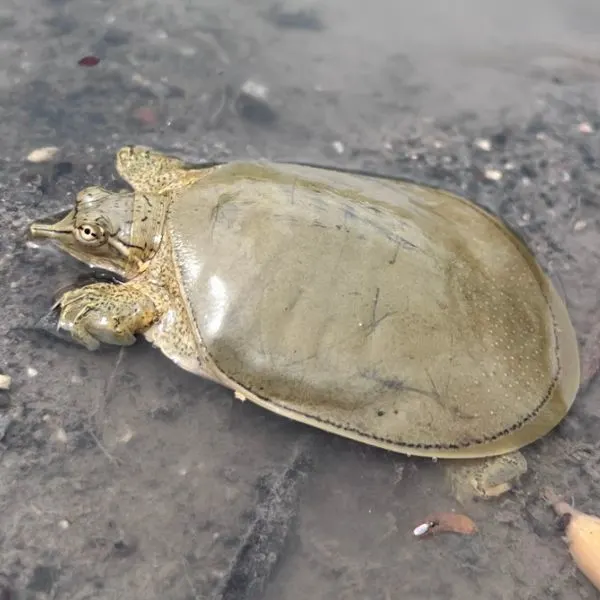
- Experience Level: Intermediate to Expert
- Family: Trionychidae
- Scientific Name: Apalone spinifera
- Other Names: N/A
- Adult Size: 5 to 9 ½ inches for males, 10 to 20 inches for females
- Life Span: Between 20 and 50 years
- Average Price Range: Between $20 and $120
- Conservation Status: Threatened in some areas
Spiny Softshell turtles have a flattened soft shell that’s flexible and floppy around the edges. They are often tan, brown, grey, or olive colored and have dark circles or spots on the top. Their plastron is small and white.
Spiny Softshells have fleshy bumps on the front of their shell and the rest of the carapace has a sand-papery feel to it.
Aside from the iconic soft shells, these turtles have long necks, extended, pig-like snouts, and stripes running along the head and limbs. They also have very long front claws and highly webbed feet.
Be extremely careful when you see these turtles out of the water. They know they don’t have much protection from predators and can be rather aggressive. Their long necks can reach longer than you think, and they have a sharp beak that can cut flesh.
These turtles like faster moving currents and inhabit streams, rivers, and lakes with sandy or muddy bottoms. They like to bury themselves in the sand and ambush prey that gets too close.
Though mostly carnivorous—feeding on crustaceans, insects, fish, and amphibians, they will occasionally feed on algae and vegetation.
Female softshell turtles are much bigger than males, often growing twice as large as male turtles.
Spotted Turtles in Michigan
9. Spotted Turtle
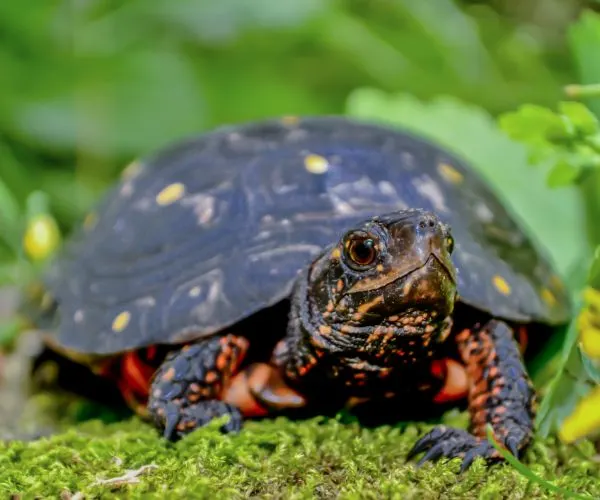
- Experience Level: Intermediate to Expert
- Family: Emydidae
- Scientific Name: Clemmys guttata
- Other Names: Polka-dot turtle, “Spotty”
- Adult Size: 4 to 5 inches
- Life Span: Males up to 65 years; females up to 110 years
- Average Price Range: $200 to $300
- Conservation Status: Endangered
Spotted turtles are a small, beautiful species, not to be confused with Blanding’s turtles. They both have dark shells and spots, but the Spotted turtle has more pronounced, yellow spots on a black shell. This turtle also has black skin and scales as well as yellow spots on the head and limbs.
These turtles are endangered, mostly because of habitat loss, human encroachment, and poaching for the pet trade. Spotties only grow to approximately 5 inches in length and are beautiful turtles so they are highly sought after.
They are also very sensitive to pollution. They prefer bogs, wetlands, and swamps. These areas are getting drained, becoming too polluted, or becoming developed so Spotted turtles are losing a lot of habitats.
Spotted turtles are semi-aquatic, and spend a lot of time wandering the thick vegetation near the watery home. They eat both aquatic and terrestrial invertebrates such as worms, insects, snails and slugs, and the occasional fish or vegetation.
Wood Turtles in Michigan
10. Wood Turtle
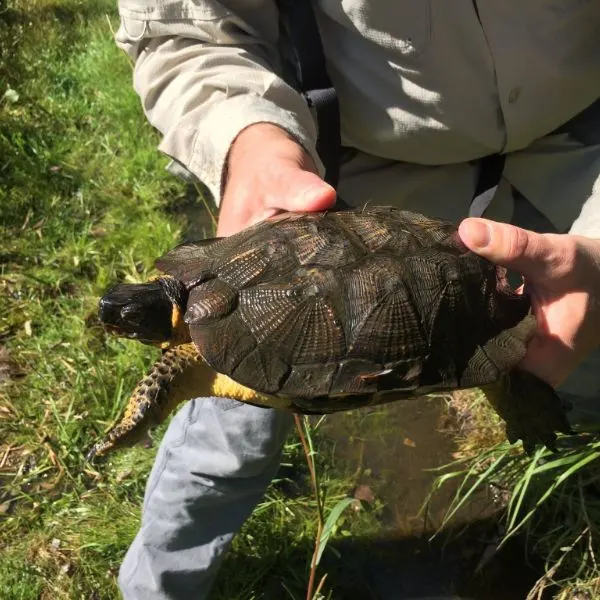
- Experience Level: Intermediate
- Family: Emydidae
- Scientific Name: Glyptemys insculpta
- Other Names: N/A
- Adult Size: 5.5 to 9 inches
- Life Span: 40 to 60 years
- Average Price Range: $250 to $500
- Conservation Status: Endangered
Other endangered species, Wood turtles are unique and intelligent turtles. Wood turtles look like they were crafted by talented wood sculptors. Their brown scutes are pyramidal and deeply furrowed which makes the carapace look like wood grain.
These turtles are semi-aquatic, and spend much of their time in the summer roaming the areas around rivers and streams.
Wood turtles face population decline because of habitat loss, human encroachment, poaching for the pet trade, and raccoon predation. Most of their nests end up getting raided by raccoons. Their eggs are also eaten by minks, ravens, foxes, and feral cats.
When looking for food, the Wood turtle is an omnivore that will eat fruits, berries, plants, snails, worms, insects, and carrion. A unique adaptation of the Wood turtle is how they trick worms into emerging from the ground.
Wood turtles will stomp the ground with their feet and shell to mimic rain. The worms, not wanting to get flooded out will emerge, only to be feasted on by the turtles.
Wrapping up
There we have it, all the turtles that can be found in Michigan. There are terrestrial species like the Eastern Box turtle, semi-aquatic turtles such as the Wood turtle, and turtles that rarely ever leave the water such as Northern Map turtles.
If you’re interested in any of these turtles as pets, seek out reputable, licensed breeders. Don’t take turtles from the wild; they don’t take well to captivity, and it may be illegal to remove certain species from their habitats.
If you enjoyed this list, leave us a comment before you go. We love to hear from our readers, and other herp enthusiasts are out there who might enjoy your information.
Other nearby states
